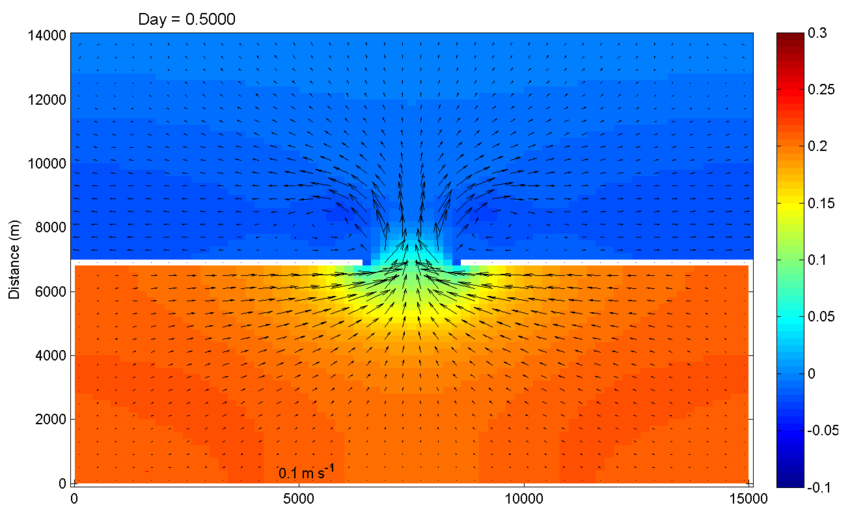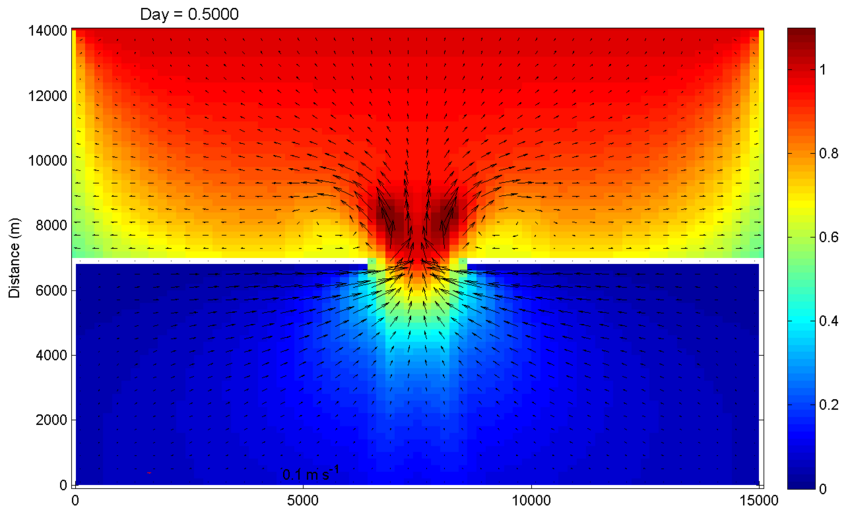INLET TEST CASE: Difference between revisions
No edit summary (change visibility) |
No edit summary (change visibility) |
||
| Line 6: | Line 6: | ||
This test case models and idealized tidal inlet system. The model domain is a 15x14 km rectangle with a uniform initial depth of 4 m. The model setup parameters are shown in the table below. The domain is separated into two regions: the seaward (top) and back-barrier (bottom) regions. The seaward region is open with radiation conditions on the western, northern and eastern edges. The back-barrier region is enclosed with four walls and is connected to the seaward region through a 2 km wide inlet. The model is forced by a tide and waves. An oscillating water level is imposed on the northern edge with a tidal amplitude of 1 m. Waves are also imposed on the northern edge with a height of 1 m, directed to the south with a period of 10s. | This test case models and idealized tidal inlet system. The model domain is a 15x14 km rectangle with a uniform initial depth of 4 m. The model setup parameters are shown in the table below. The domain is separated into two regions: the seaward (top) and back-barrier (bottom) regions. The seaward region is open with radiation conditions on the western, northern and eastern edges. The back-barrier region is enclosed with four walls and is connected to the seaward region through a 2 km wide inlet. The model is forced by a tide and waves. An oscillating water level is imposed on the northern edge with a tidal amplitude of 1 m. Waves are also imposed on the northern edge with a height of 1 m, directed to the south with a period of 10s. | ||
Files to run this test case can be downloaded | Files to run this test case can be downloaded [[media:Inlet_test_config.zip|here]]. | ||
Table 1. Important model parameters: | Table 1. Important model parameters: | ||
Revision as of 16:28, 7 January 2009
This test case couples ROMS and SWAN directly using the Modeling Coupling Toolkit (MCT) library. To run this application the user needs to activate INLET_TEST. It only can be run in distributed-memory (MPI) since the parallel threads are split to run both ROMS and SWAN at the same time. This test illustrates the significance of wave-current coupling. This application and coupling methodology is described in Warner et al. (2008).
This test case models and idealized tidal inlet system. The model domain is a 15x14 km rectangle with a uniform initial depth of 4 m. The model setup parameters are shown in the table below. The domain is separated into two regions: the seaward (top) and back-barrier (bottom) regions. The seaward region is open with radiation conditions on the western, northern and eastern edges. The back-barrier region is enclosed with four walls and is connected to the seaward region through a 2 km wide inlet. The model is forced by a tide and waves. An oscillating water level is imposed on the northern edge with a tidal amplitude of 1 m. Waves are also imposed on the northern edge with a height of 1 m, directed to the south with a period of 10s.
Files to run this test case can be downloaded here.
Table 1. Important model parameters:
| Model Parameter | Variable | Value |
|---|---|---|
| length, width, depth | Xsize, Esize, hmax | 15000 m, 14000 m, 4.0 m |
| number of grid spacings | Lm, Mm, N | 75, 70, 10 |
| bottom Roughness | Zob | 0.015 m |
| time step | dt | 10 s |
| simulation steps | ntimes | 17280 steps (2 days) |
| morphology factor | morph_fac | 10 (=20 day scaled simulation) |
| grain size | Sd50 | 0.10 mm |
| settle velocity | Wsed | 11.0 mm s-1 |
| erosion rate | Erate | 5 x 10-3 kg m-2s-1 |
| critical stress | tau_cd, tau_ce | 0.10 Nm-2 |
| porosity | poros | 0.50 |
| bed thickness | bed(:, :, :, ithck) | 10.0 m |
| northern edge tide | A, Tt | 1.0 m, 12 h |
| northern edge wave height | Hsig | 2 m |
| northern edge wave period | T | 10 s |
| northern edge wave direction | θ | from 0° (from North) |
Below we provide a brief example of the model output.

